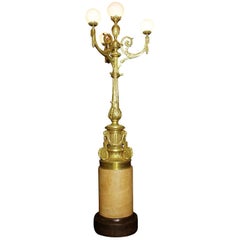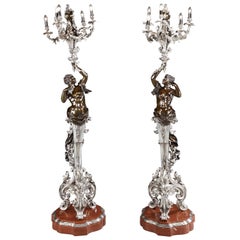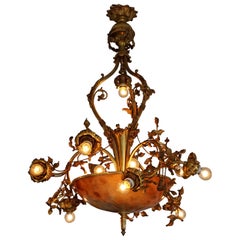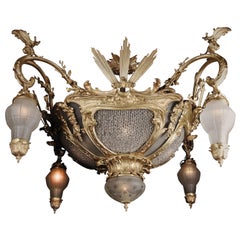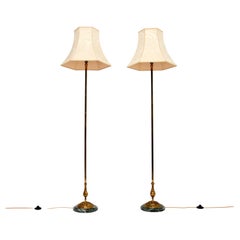Marble Floor Lamps
2
to
1
1
1
2
2
2
492
176
21
16
14
8
8
5
4
3
3
2
2
1
1
1
1
1
1
Height
to
Width
to
1
1
34,678
6
6
4
4
2
2
Style: Louis XV
Material: Marble
Fine French 19th-20th Century Louis XV Style Belle Epoque Gilt-Bronze Torchere
Located in Los Angeles, CA
A fine and Large French 19th-20th century Louis XV Style Belle Époque gilt bronze four-light torchère with Laurel Wreaths with white opaline glass globes, raised on a two-tone circul...
Category
Early 1900s French Louis XV Antique Marble Floor Lamps
Materials
Marble, Bronze
Pair of 19th Century French Patinated and Silvered Bronze Torchères Floor Lamps
Located in London, GB
Important Pair of Antique Torchères in the Louis XV Manner
Constructed in patinated and silvered bronze, and rouge brecciated marble; rising from serpentine marble bases, trimmed with silvered bronze tied cannelures, the tripartite scrolled legs issue columns incorporating addorsed syrinxes, holding reeded Pan pipes...
Category
19th Century French Louis XV Antique Marble Floor Lamps
Materials
Marble, Bronze
Related Items
Fine Gilt Bronze and Alabaster Belle Époque Chandelier
Located in Antwerp, BE
A fine bronze and alabaster Belle Époque chandelier, shaped as swirling and flowering rose branches, early 20th century.
Dimensions: Diameter...
Category
Late 19th Century French Art Nouveau Antique Marble Floor Lamps
Materials
Alabaster, Brass, Bronze, Copper
20th Century Louis XV Style Cast-Bronze Candelabra Chandelier
Located in Berlin, DE
Monumental highly significant candelabra in Louis XV style.
Unusual, finely engraved and cast bronze. Balustrade formed, profile-framed corpus connected with wide, ornamental reliefed, hoops, crowned by sunbeams. There from, four curved light arms, ending in bell formed traffic-light style. On the wide hoop, can be found Rococo cartouches. Under which are profiled medallion-like framing Provenance: Princess Shwikar (King Farouk...
Category
20th Century Louis XV Marble Floor Lamps
Materials
Crystal, Bronze
Pair French 19th-20th Century Neoclassical Style Iron and Parcel-Gilt Torcheres
Located in Los Angeles, CA
A Palatial Pair of French 19th/20th Century Neoclassical Revival Style Ebonized Cast-Iron and Parcel-Gilt Torcheres (torchières - Lamp Posts). The park-like torcheres surmounted with...
Category
Early 1900s French Neoclassical Revival Antique Marble Floor Lamps
Materials
Iron, Zinc
19th Century French Louis XV Style Bronze Chandelier
Located in Dallas, TX
French Louis XV style bronze chandelier from the late 19th century. This Rococo style ten-light chandelier is cast bronze and has an a...
Category
Late 19th Century French Rococo Antique Marble Floor Lamps
Materials
Bronze
19th Century French Rococo Revival Style Bronze Patinated Dragons Floor Lamp
Located in Plainview, NY
An exceptional late 19th century rare French Rococo revival style floor lamp featuring amazing details. The floor lamp is made of bronze and shows great patina adding Beauty and char...
Category
Late 19th Century Rococo Revival Antique Marble Floor Lamps
Materials
Bronze
H 72.5 in W 10.5 in D 10.5 in
An Italian 19th Century Patinated Bronze Torchere, After Niccolò Roccatagliata
By Niccolo Roccatagliata
Located in Los Angeles, CA
A Large and Impressive Italian 19th Century Patinated Bronze Figural Torchere, after a model by Niccolò Roccatagliata (Genoa 1593 - Venice 1636). The triangular foot base with projecting putti supporting the stem and oval reserves within cartouche motifs, one containing the initials "S.D" with an olive tree in-between and a bull-head below. The stem knot with figures of winged caryatids and festoons and upper part with cherub heads, acanthus leaves and egg and bead patterns and topped with a later white glass globe. The decorative system refers to the documented artistic production of the Venetian workshop of Niccolò Roccatagliata and takes inspirational model from the base of the Renaissance bronze of the Scuola Grande di San Teodoro in Venice, a work signed by Andrea del Bartolomeo di Alessandri known as Brescianino. Electrified. Circa: Venice, 1850-1880.
RELATED LITERATURE
L. Planiscig, Venezianische Bildhauer der Renaissance, Vienna, 1921, figs. 661-664; C. Avery, 'Andrea del Bartolomeo di Alessandri detto il Bresciano" lavator di gettar di Bronzo": candelabri, satiri e battenti', M. Ceriana and V. Avery (eds.), L'Industria artistica del Bronzo del Rinascimento a venezia e nell'Italia settentrionale, Venice, 2008, pp. 233-252.
Similar models of this torchere were part of the interior decor collection at the Vanderbilt Mansion in New York (see black and white photo). The Cornelius Vanderbilt II House was a large mansion built in 1883 at 1 West 57th Street in Manhattan, New York City. It occupied the frontage along the west side of Fifth Avenue from West 57th Street up to West 58th Street at Grand Army...
Category
19th Century Italian Baroque Antique Marble Floor Lamps
Materials
Bronze
H 66.5 in W 19.25 in D 18 in
19th Century Antique Japanese Meiji Bronze Floor Lamp
Located in Point Richmond, CA
19th century antique Japanese Meiji bronze floor lamp.
This finely cast, well composed, pedestal lamp depicts mythical creatures on the base, cranes in high relief on the stem are...
Category
Late 19th Century Japanese Meiji Antique Marble Floor Lamps
Materials
Bronze
Pair of French Belle Époque 19th-20th Century Gilt Bronze and Alabaster Torchere
Located in Los Angeles, CA
A palatial pair of French Belle Époque 19th-20th century gilt bronze and alabaster tall torchières. The slender center column raised on a circular intri...
Category
Early 1900s French Belle Époque Antique Marble Floor Lamps
Materials
Alabaster, Bronze
Pair 19th Century Japanese Imari Porcelain & Gilt-Bronze Torchere Candelabra
Located in Los Angeles, CA
A fine Pair of 19th century Japanese Imari Porcelain and French Gilt-Bronze Mounted Thirteen-Light Celadon Torchere Candelabra. The bottle-shaped Japonisme vases with a Royal red background, decorated with parcel-gilt and black soaring eagles in the hunt within a forestall scene. Each Vase fitted and surmounted with a French 19th century Louis XV Style 13-Light scrolled candelabrum and all raised on a circular pierced gilt-bronze plinth. circa: 1880.
Imari Porcelain (????) is the name for Japanese porcelain wares made in the town of Arita, in the former Hizen Province, northwestern Kyushu. They were exported to Europe extensively from the port of Imari, Saga, between the second half of the 17th century and the first half of the 18th century. The Japanese as well as Europeans called them Imari. In Japanese, these porcelains are also known as Arita-yaki (???). Imari or Arita porcelain has been continously produced up through the present day.
Characteristics
Though there are many types of Imari, Westerners' conception of Imari in the popular sense is associated only with a type of Imari produced and exported in large quantity in mid-17th century. This type is called Kinrande. Kinrande Imari is colored porcelain with cobalt blue underglaze and red and gold overglaze. The color combination was not seen in China at that time. Traditional Ming dynasty color porcelain used dominantly red and green, probably due to scarcity of gold in China, whereas gold was abundant in Japan in those days. The subject matter of Imari is diverse, ranging from foliage and flowers to people, scenery and abstractions. Some Imari design structures such as kraak style were adopted from China, but most designs were uniquely Japanese owing to the rich Japanese tradition of paintings and costume design. The porcelain has a gritty texture on the bases, where it is not covered by glaze. There is also blue and white Imari. Kakiemon style Imari is another type of Imari, but it tends to be categorized separately in Europe.
History
"Imari" was simply the trans-shipment port for Arita wares. It was the kilns at Arita which formed the heart of the Japanese porcelain industry.
Arita's kilns were set up in the 17th century, when kaolin was discovered in 1616 by the immigrant Korean potter, Yi Sam-pyeong (1579–1655). (He may also be known by the name, "Kanage Sambei".) Yi Sam-Pyeong, along with his extended family of 180 persons, left Korea on the offer of a privileged position in Japan. This decision was made after the occurrence of certain Japanese invasions of Korea. After Yi Sam-Pyeong's discovery, his kilns began to produce revised Korean-style blue and white porcelains, known as "Shoki-Imari".
In the mid-17th century there were also a lot of Chinese refugees in Northern Kyushu due to the turmoil on Chinese continent, and it is said one of them brought coloring technique to Arita. Thus Shoki-Imari developed into Ko-KutaniImari. Ko-Kutani was produced around 1650 for both export and domestic market. Blue and white porcelain continued to be produced and they are called Ai-Kutani. Ko-Kutani Imari for the export market usually adopted Chinese design structure such as kraak style, whereas Ai-Kutani for the domestic market were highly unique in design and are accordingly valued very much among collectors.
Ko-Kutani style evolved into Kakiemon style Imari, which was produced for about 50 years around 1700. Imari achieved its technical and aesthetic peak in Kakiemon style, and it dominated European market. Blue and white Kakiemon is called Ai-Kakiemon. Kakiemon style transformed into Kinrande in the 18th century. Kinrande used blue underglaze and red and gold overglaze, and later some other colors.
Imari began to be exported to Europe because the Chinese kilns at Ching-te-Chen were damaged in the political chaos and the new Qing dynasty government stopped trade in 1656–1684. Exports to Europe were made through the Dutch East India Company, but the designation "Imari Porcelain" in Europe connotes Arita wares of mostly Kinrande Imari.
Export of Imari to Europe stopped in mid-18th century when China began export to Europe again, since Imari was not able to compete against China due to high labor cost. By that time, however, both Imari and Kakiemon style were already so popular among Europeans, Chinese export porcelain copied both Imari and Kakiemon style, which is called Chinese Imari. At the same time, European kilns, such as Meisen also tried to copy Imari and Kakiemon.
Export of Imari surged again in late 19th century (Meiji era) when Japonism flourished in Europe. Thus in western world today, two kinds of Imari can...
Category
19th Century Japanese Japonisme Antique Marble Floor Lamps
Materials
Ormolu, Bronze
20th Pair of Spanish Renaissance Style Bronze Pricket Floor Lamps, Torchères
Located in Miami, FL
Pair of Renaissance style bronze pricket lamps.
These large pricket lamps provide the perfect balance for rooms with large-scale and impact.
Newly wired.
Category
Early 20th Century Spanish Renaissance Revival Marble Floor Lamps
Materials
Bronze
H 39.37 in W 7.5 in D 7.5 in
19th Century Torchere Wrought Iron Floor Lamp
Located in Dallas, TX
Forged from solid iron and still showing traces of its original painted finish that has achieved a Fine patina, this 19th century floor lamp was originally designed for a candle, and...
Category
1870s French Country Antique Marble Floor Lamps
Materials
Wrought Iron
French Late 19th Century Belle Epoque Style Gilt Bronze Chandelier
By Pierre Gouthiere
Located in Vancouver, British Columbia
A gilt and patinated bronze chandelier very much in the Louis XVI style; three gilt chains hang from a draped canopy and connect with three goats heads which hold the upper three scr...
Category
1890s French Louis XVI Antique Marble Floor Lamps
Materials
Bronze
Previously Available Items
Pair of Antique French Brass & Marble Floor Lamps
Located in London, GB
A stunning pair of antique French floor lamps in solid brass with beautiful green marble bases. They date from around the 1920-30’s.
They are of lovely quality, with gorgeous detai...
Category
1920s French Louis XV Vintage Marble Floor Lamps
Materials
Marble, Brass
Recently Viewed
View AllMore Ways To Browse
Pair Of 19th Century Floor Lamps
Five Light Floor Lamp
Mid Century Modern Arc Floor Lamp
Mid Century Wood Floor Lamp Table
Vintage Modern Wood Floor Lamp
Midcentury Triple Lamp
Hollywood Regency Palm Tree Lamp
Bespoke Floor Lamp
Metal Torchiere Floor Lamp
Marble Standing Lamp
Scandinavian Teak Floor Lamp
Vintage Floor Cloth
Black Wrought Iron Floor Lamp
Cedric Hartman Brass
Brass Standing Lamp With Brass Shade
Black Paper Floor Lamp
Woven Floor Lamp
Art Nouveau Lamp Floor
